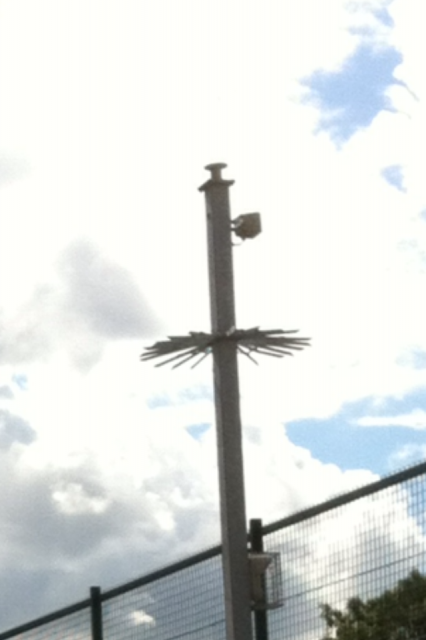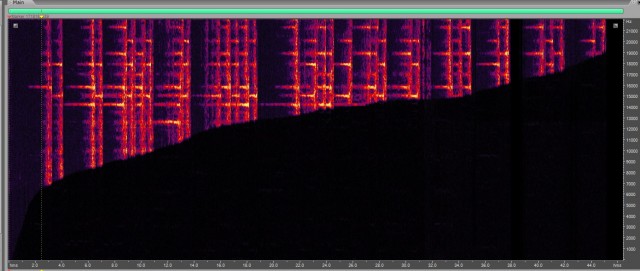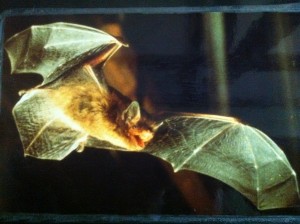Inaudible Worlds – Making the antidote to the Mosquito Deterrent
Have you heard of the ‘Mosquito Deterrent’?
It’s a device that broadcasts an ‘extremely annoying’ and ‘highly irritating’ high frequency sound, usually around 17kHz, that only younger more sensitive ears can hear. It’s said to deter young people from staying in some public places – and prevent the presence of ‘anti social behaviour from vandals and drug users’. I quote one of the companies that make them. http://movingsoundtech.com/ It unfortunately doesn’t just target the ‘vandals and drug users’ as stated, it targets all young people, and consequently it seems infers that all young people are ‘criminals’.
In answer to the unpleasant Mosquito Deterrent I’m in the process of making a sound installation that is hopefully pleasant to hear and is solely for young people- being in a high frequency that only younger people can hear. (Older people can’t usually hear these frequencies because their ears naturally loose sensitivity to higher frequencies.) For older people who can’t hear the sounds – this will be a bit like a sound art version of The Emperors New Clothes!

Mosquito Deterrent outside a local school.
Although the device claims to be ‘harmless’, David McAlpine, who is the director of the UCL Ear Institute and Professor of Auditory Neuroscience and who’s research looks at different causes of hearing loss, said it is ‘damaging children’s hearing’. (Keynote address Supersonix Conference 2012). https://iris.ucl.ac.uk/research/personal?upi=DMCAL14 As a gesture towards those discriminated against, I thought I’d make a sound work that only young ears could hear – that there was a choice to hear or not – and that aimed to be pleasant rather than unpleasant: a Mosquito ANTI Deterrent.
Is there such a thing as a pleasant high frequency sound?
To see how sounds behaved when they were pitch shifted up to a high frequency I made some tests with the help of Paul Dibly. Here is a piano recording gradually pitch shifted higher and higher from 12khz – 19kHz. (Done on CPD soft ware)
http://www.tsascience.com.au/images/pdf/LEB/LEB04_01
[audio:https://shirleypegna.com/wp-content/uploads/2012/10/piano-shifting-up1.mp3|titles=piano shifting up1]
Piano sounds -Use head phones to listen

Here is a screen shot of the CPD soft ware that made the sounds. The black shows lower frequencies being cut so the sounds are shifted higher and higher.
Find out when your ears loose sensitivity by listening to the track with a timer.
If for instance, you can’t hear anything after 24 seconds – find 24s on the graph (on the horizontal) and you will see it corresponds to 14kHz (on the vertical).
I wanted to see how these different recordings (below) behaved when their pitch was shifted up. To be inclusive they are first in an adult audible range of around 9kHz.
• Can you tell which are sparrows, which are repeated chords and which are bike wheels?
• Which do you prefer – or do they all give you a headache?
Use headphones to listen.
[audio:https://shirleypegna.com/wp-content/uploads/2012/10/9kHz1.mp3|titles=9kHz1]
[audio:https://shirleypegna.com/wp-content/uploads/2012/10/9kHz2.mp3|titles=9kHz2]
[audio:https://shirleypegna.com/wp-content/uploads/2012/10/9kHz3.mp3|titles=9kHz3]
Here are the same recordings shifted up around the 17kHz range.
• Can you hear them? Which do you prefer?
• Do they all give you a headache?
[audio:https://shirleypegna.com/wp-content/uploads/2012/10/17kHz1.mp3|titles=17kHz1]
[audio:https://shirleypegna.com/wp-content/uploads/2012/10/17kHz2.mp3|titles=17kHz2]
[audio:https://shirleypegna.com/wp-content/uploads/2012/10/17kHz3.mp3|titles=17kHz3]
It may or may not be possible to get a consensus of ‘pleasant’ sounds at the top of a persons hearing range, because of the way sounds behave differently when pitch shifted up, particularly when maintaining the original tempo. It may depend on a) the soft ware used to pitch shift them and the resulting alga-rhythms heard and b) the changed quality or texture of the fundamental note, if you are unable to hear the harmonics above it. http://www.tsascience.com.au/images/pdf/LEB/LEB04_01.pdf
Sound artist Bim Williams introduced me to different soft ware: Pro Tools, Ableton Live and Melodyne, to listen to their pitch shifting capabilities – and they varied considerably.
To create a questionnaire for purely likes and dislikes for these sounds- although subjective – could be straight forward, given controlled circumstances, but more interestingly our perceptions of sound depend not only on the mechanisms of the ear but the use of our imaginations.
I went to listen and record some fruit bats in the Cotswold Wildlife Park. http://www.cotswoldwildlifepark.co.uk/ . Here are some audible beeps from them.
[audio:https://shirleypegna.com/wp-content/uploads/2012/10/fruit-bats-chatting.mp3|titles=fruit bats chatting]

Fruit Bat
The inaudible – to me – echolocation sound world of some bats, is one I can I only imagine. Bats are known to emit sound up to and in the range of 95kHz-
http://www.sciencedirect.com/science/article/pii/037859559290018I
At both ends of the inaudible scale for human ears, creatures communicate: the Blind Ganges Dolphin up to 200kHz and the Blue Whale down to 10Hz. (Krause.B 2012)
Our hearing being generally around 12kHz and higher for young people under 25. Ear tests at the clinic are often at around 8kHz (McAlpine 2012). These high and low frequencies – out of our range of hearing are audible worlds we can only imagine, and I can only guess with my ears what the Mosquito Deterrent sound is like.
We can only imagine these worlds that don’t come in to our hearing range, and once we know of our lack of mechanism to hear one sound world, it opens up the possibilities
that there are a multitude of other worlds to imagine that can be heard – if not by our ears then by others.
It remains to be seen whether there is a consensus about what is a pleasant high frequency sound, and what qualities it has and how that can be described to those who can’t hear it. It will be interesting to create a framework to be able to assess this. I was told about a very interesting framework to assess in detail the cause and effect of sound by Doug Bott a musician and music educator who works with young musicians with learning difficulties. http://soundsofintent.org/about-soi
I may or may not find sound that is pleasant for young ears to hear in a Mosquito ANTI Deterrent at all, but I’m now definitely interested in the worlds of sound I can only imagine and how our imagination comes in to play.
(Just to let you know- the first of each three sounds was bike wheel sounds, the second chords and the third sparrows.)
End